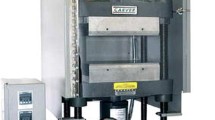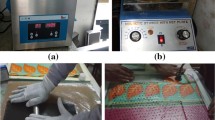Abstract
Design of polymer composites for tribological applications is a multi-criteria optimization problem. Two-body abrasive wear (2-BAW) behaviour of thermoplastic copolyester elastomer (TCE) reinforced with and without short glass fiber, filled with various fillers (short carbon fiber, polytetrafluoroethylene, silicon carbide and alumina) in different proportions were influenced by the properties of their constituents. 2-BAW behaviour of multi-phased TCE composites was evaluated using pin-on-disc apparatus. This paper presents an approach to establish the model for predicting the specific wear rate (Ks) of TCE composites. Three-factors and three-levels, facecentered central composite design was used for conducting tests. Response surface methodology was applied to derive the second order quadratic model with the selected parameters. The results indicated that the Ks increases with increase in fiber/filler content and decreases with increase in grit size of silicon carbide (SiC) abrasives and abrading distance. The investigation also revealed that the fiber/filler content is the most influencing factor, followed by grit size of SiC abrasives and abrading distance. The predicted results show close agreement with the experimental. Hence the developed model could be used to predict abrasion behaviour of multi-phased TCE composites satisfactorily. The worn surfaces of TCE composites were analyzed with the help of scanning electron microscope.
Similar content being viewed by others
References
Wang, R. M., Zheng, S. R., and Zheng, Y. P., “Polymer Matrix Composites and Technology,” Woodhead Publishing, pp. 29–30, 2011.
Rajashekaraiah, H., Mohan, S., Pallathadka, P. K., and Bhimappa, S., “Dynamic Mechanical Analysis and Three-Body Abrasive Wear Behaviour of Thermoplastic Copolyester Elastomer Composites,” Advances in Tribology, Vol. 2014, Article ID: 210187, 2014.
Hemanth, R., Suresha, B., and Sekar, M., “Physico-Mechanical Behaviour of Thermoplastic Co-Polyester Elastomer/ Polytetrafluroethylene Composite with Short Fibers and Microfillers,” Journal of Composite Materials, Vol. 49, No. 18, pp. 2217–2229, 2014.
Hutton, T. J., Johnson, D., and McEnaney, B., “Effects of Fibre Orientation on the Tribology of a Model Carbon-Carbon Composite,” Wear, Vol. 249, No. 8, pp. 647–655, 2001.
Neale, M. and Gee, M., “A Guide to Wear Problems and Testing for Industry,” William Andrew, p. 8, 2001.
Harsha, A. P. and Tewari, U. S., “Two-Body and Three-Body Abrasive Wear Behaviour of Polyaryletherketone Composites,” Polymer Testing, Vol. 22, No. 4, pp. 403–418, 2003.
Bijwe, J., Indumathi, J., Rajesh, J. J., and Fahim, M., “Friction and Wear Behavior of Polyetherimide Composites in Various Wear Modes,” Wear, Vol. 249, No. 8, pp. 715–726, 2001.
Friedrich, K. and Cyffka, M., “On the Wear of Reinforced Thermoplastics by Different Abrasive Papers,” Wear, Vol. 103, No. 4, pp. 333–344, 1985.
Harsha, A. P. and Tewari, U. S., “Abrasive Wear of Glass Fibre Reinforced Polysulfone Composites,” Indian Journal of Engineering and Materials Sciences, Vol. 9, No. 3, pp. 203–208, 2002.
Kumar, B. R., Venkataramareddy, M., and Suresha, B., “Two-Body Abrasive Wear Behavior of Nano-Clay Filled LDPE/EVA Composites,” Journal of Reinforced Plastics and Composites, Vol. 28, No. 24, pp. 2999–3007, 2009.
Bijwe, J., Sen, S., and Ghosh, A., “Influence of PTFE Content In PEEK-PTFE Blends on Mechanical Properties and Tribo-Performance in Various Wear Modes,” Wear, Vol. 258, No. 10, pp. 1536–1542, 2005.
Unal, H., Sen, U., and Mimaroglu, A., “Abrasive Wear Behaviour of Polymeric Materials,” Materials & Design, Vol. 26, No. 8, pp. 705–710, 2005.
Harsha, A. P. and Tewari, U. S., “Tribo Performance of Polyaryletherketone Composites,” Polymer Testing, Vol. 21, No. 6, pp. 697–709, 2002.
Bijwe, J., Neje, S., Indumathi, J., and Fahim, M., “Friction and Wear Performance Evaluation of Carbon Fibre Reinforced PTFE Composite,” Journal of Reinforced Plastics and Composites, Vol. 21, No. 13, pp. 1221–1240, 2002.
Suresha, B., Ramesh, B. N., Subbaya, K. M., Kumar, B. R., and Chandramohan, G., “Influence of Graphite Filler on Two-Body Abrasive Wear Behaviour of Carbon Fabric Reinforced Epoxy Composites,” Materials & Design, Vol. 31, No. 4, pp. 1833–1841, 2010.
Pasha, B. A. M., Budan, D. A., Basavarajappa, S., Yadav, S. M., and Nizamuddin, B., “Studies on Wear Resistance of PTFE Filled with Glass and Bronze Particles based on Taguchi Technique,” Journal of Thermoplastic Composite Materials, Vol. 26, No. 2, pp. 243–259, 2013.
Oh, J.-Y., Lee, G.-H., Kang, H.-S., and Song, C.-S., “Modeling and Performance Analysis of Rock Drill Drifters for Rock Stiffness,” Int. J. Precis. Eng. Manuf., Vol. 13, No. 12, pp. 2187–2193, 2012.
Mishra, P., “Statistical Analysis for the Abrasive Wear Behavior of Bagasse Fiber Reinforced Polymer Composite,” International Journal of Applied Research in Mechanical Engineering, Vol. 2, pp. 7–11, 2012.
Yoon, H.-S., Wu, R., Lee, T.-M., and Ahn, S.-H., “Geometric Optimization of Micro Drills using Taguchi Methods and Response Surface Methodology,” Int. J. Precis. Eng. Manuf., Vol. 12, No. 5, pp. 871–875, 2011.
Thakre, A. A., “Prediction of Erosion of Polyetherimide and Its Composites using Response Surface Methodology,” Journal of Tribology, Vol. 137, No. 1, Paper No. 011603, 2015.
Li, Z.-Z., Cheng, T.-H., Xuan, D.-J., Ren, M., Shen, G.-Y., and Shen, Y.-D., “Optimal Design for Cooling System of Batteries using DOE and RSM,” Int. J. Precis. Eng. Manuf., Vol. 13, No. 9, pp. 1641–1645, 2012.
Song, C.-H., Kwon, K.-B., Park, J.-Y., Oh, J.-Y., Lee, S., Shin, D.-Y., and Cho, J.-W., “Optimum Design of the Internal Flushing Channel of a Drill Bit using RSM and CFD Simulation,” Int. J. Precis. Eng. Manuf., Vol. 15, No. 6, pp. 1041–1050, 2014.
Kumar, S. and Balasubramanian, V., “Effect of Reinforcement Size and Volume Fraction on the Abrasive Wear Behaviour of AA7075 Al/ SiCp P/M Composites-A Statistical Analysis,” Tribology International, Vol. 43, No. 1, pp. 414–422, 2010.
Suresha, S. and Sridhara, B., “Effect of Silicon Carbide Particulates on Wear Resistance of Graphitic Aluminium Matrix Composites,” Materials & Design, Vol. 31, No. 9, pp. 4470–4477, 2010.
Chauhan, S. R. and Dass, K., “Dry Sliding Wear Behaviour of Titanium (Grade 5) Alloy by Using Response Surface Methodology,” Advances in Tribology, Vol. 2013, Article ID: 272106, 2013.
Montgomery, D. C., “Design and Analysis of Ewperiments,” Wiley, p. 251, 2007.
Author information
Authors and Affiliations
Corresponding author
Rights and permissions
About this article
Cite this article
Rajashekaraiah, H., Bheemappa, S., Yang, SH. et al. Abrasive wear behaviour of thermoplastic copolyester elastomer composites: A statistical approach. Int. J. Precis. Eng. Manuf. 17, 755–763 (2016). https://doi.org/10.1007/s12541-016-0093-x
Received:
Revised:
Accepted:
Published:
Issue Date:
DOI: https://doi.org/10.1007/s12541-016-0093-x




